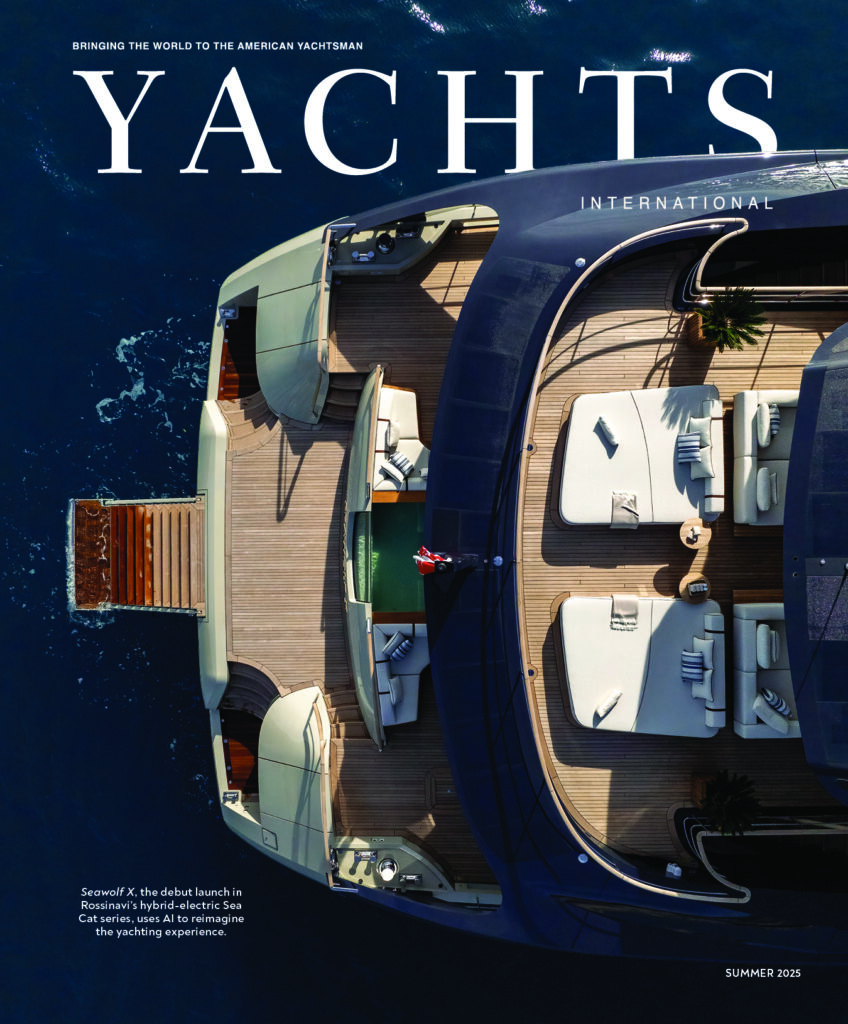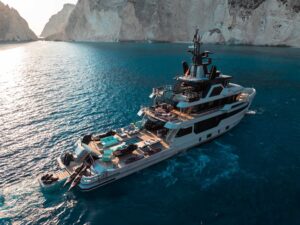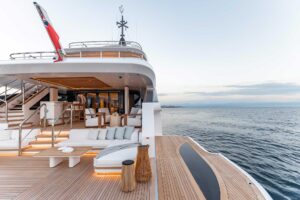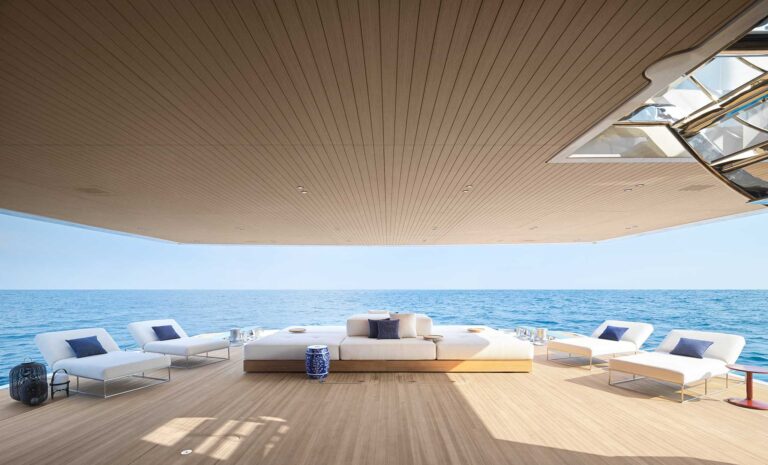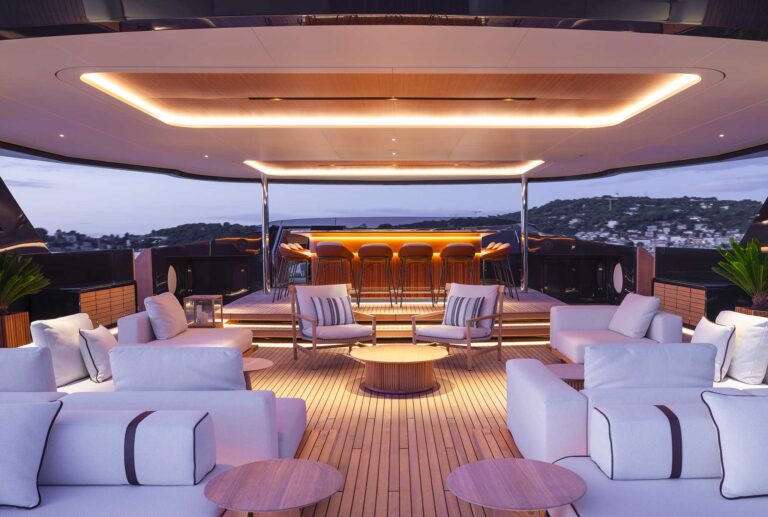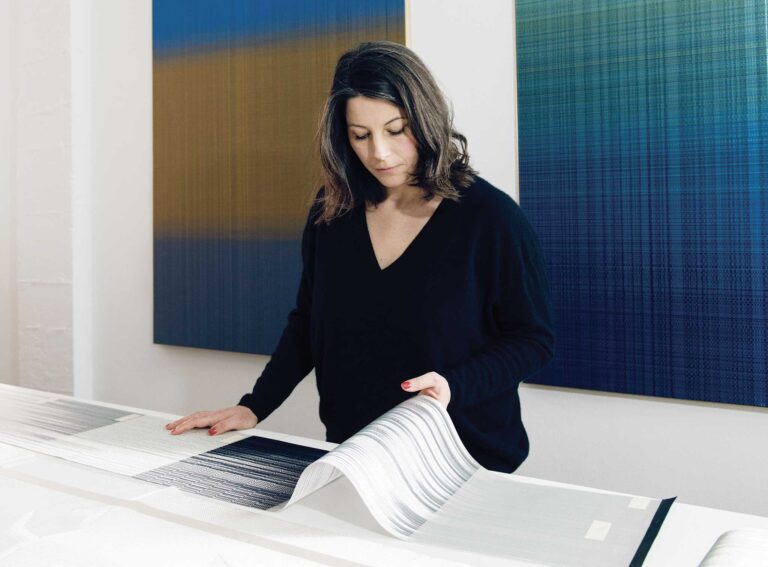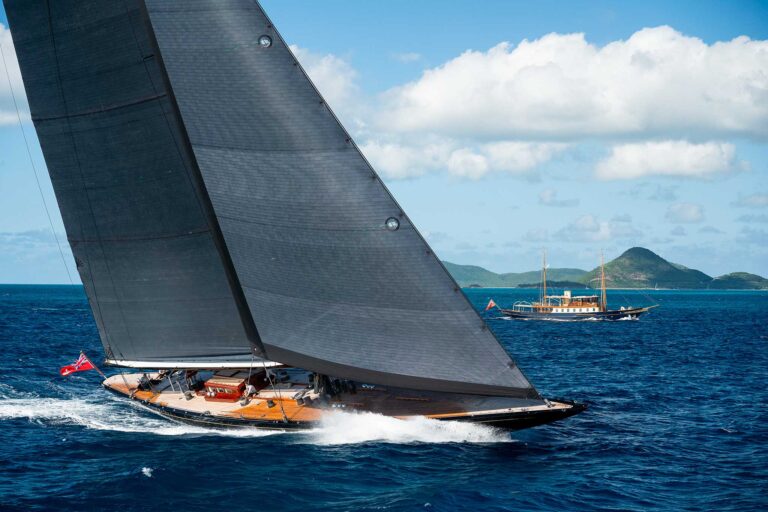The most compact of the Taiwan builder’s expedition-style series not only promises extended cruise range and admirable interior volume, it delivers.
Horizon Yachts may be best known for its E-Series line of luxurious and highly styled semi-displacement motoryachts, but for the past several years the builder has been busy at its Kaohsiung headquarters and its four yards expanding into other categories as well. Its fleet of Premier contemporary-styled trideck designs from 110 to 160 feet has established the Horizon brand in the megayacht sector, and the virtually simultaneous launch of its V series—currently including two Greg Marshall-designed vessels at 68 feet and 74 feet—has found an audience among clients favoring more conservative but equally contemporary styling, semi-displacement speeds and generous interior dimensions. Horizon also offers its RP range, a flotilla of raised-pilothouse yachts from 97 to 120 feet, a 52-foot sportfishing yacht (T series) and a power catamaran range that now includes an 80-foot and a 58-foot PC. Add Horizon’s Euro-styled sport yachts and a pair of solar-powered cats (SC) at 23 feet and 46 feet, and there’s something for nearly any powerboating preference. For good measure, Horizon also operates Atech, a 300,000-square-foot lamination and tooling facility, and its own furniture shop.
While continuing to produce and market its product lines vigorously, about four years ago the Horizon product-planning team began the development of yet another subset in response to a growing demand for expedition-style displacement yachts capable of achieving passagemaking range, significantly lower fuel consumption and a level of comfort consistent with the demands of extended cruise itineraries.
Smallest of this series—a 77-foot version is in full production and a steel-hulled 148-footer is nearing completion—the Horizon EP69, made its North American debut in 2011 in Seattle. Roche Harbor, a photogenic resort community and cruise destination in Washington’s San Juan Islands, provided an agreeable venue for a leisurely inspection of this intriguing new vessel.
The first impression is, well, impressive. Although a compact 69 feet, 5 inches in LOA, the EP69 appears every bit the seagoing voyager, offering as it does a tall, burly profile and a broad-shouldered demeanor, the product of its 20-foot beam. The introductory EP69 features an eye-catching deep metallic-red Alexseal hull paint with white superstructure, a color scheme that calls attention to the high forward sheerline and comparably generous freeboard aft. Appropriately, deck hardware—including bollard-style cleats, roller fairleads, 2-inch handrails and anchor chafe plates—is megayacht caliber, and the bulbous bow reflects the vessel’s bluewater design intent. A broad transom platform facilitates boarding, with access to the main deck by way of port-and-starboard curved stairways. Wide walkaround decks on either side of the deckhouse ensure unrestricted passage forward, then up two steps to wheelhouse level. A Portuguese bridge opens at centerline to the foredeck and to a pair of Maxwell 3500C anchor windlasses. Here, the test boat features optional rack storage, recessed into the forward face of the bridge coaming, capable of securing six good-size fenders.
Side decks or not, 20 feet of beam on a 69-foot displacement motoryacht will get you generous interior volume, which the Horizon design team has put to good use in a straightforward, logical arrangement. In the salon, a freestanding sofa and adjacent matching chair face a table that rises electrically to dining-table height. To starboard, two occasional chairs flanking an optional pop-up flat-screen TV augment dining capacity. Just forward is a compact galley fitted with granite countertops, a full-size refrigerator, range, double sink and dishwasher. A cabinet suspended from the overhead provides separation from the salon while supplementing storage space.
The pilothouse encloses a comparably functional command center equipped with an integrated Raymarine navigation package. A moderately reversed windshield provides good sightlines from either of two pedestal helm chairs and from the raised banquette built into the port aft corner, and port-and-starboard doors lead directly to side decks. A stairway leads through a weathertight hatch to the flybridge deck.
Nowhere is the EP69’s interior volume put to better use than in the lower deck plan, an arrangement that allows for three ensuite staterooms: a midship master with king-size berth, a forward VIP with island queen berth, and a starboard-side guest room with adult-size upper and lower berths and, unusually, its own head with stall shower and good-size vanity. The full-beam master includes a starboard-side head with large vanity and separate compartments for the toilet and shower. In the port hull side is an oval portlight that illuminates the entire space and offers a remarkable sea-level view. A fourth accommodation—nominally designated for crew but well suited to serve as an additional guest stateroom—lies aft, accessible via the watertight transom door.
Topside venues permit a variety of on-deck activities—or in the case of the two flybridge sun pads, no activity at all. A broad expanse at the after end of the bridge deck has room for a tender and an optional Steelhead Marine ES 1500 hydraulic crane. The social center at this upper level assuredly will be the portside bar and entertainment center, fitted with a propane grill and available with icemaker, under-counter fridge and three wall-mount stools. Opposite, a raised settee seats six around a large dining table, and an optional composite hardtop shelters the forward half of the bridge deck. The portside upper helm station features an electrically operated high-low instrument console that may be set at any height to optimize the view ahead. A molded stairway in the aft port corner leads to the aft main deck, where a large dining/cocktail settee extends across the transom between the two access stairways.
The engine room’s arrangement and equipment list underscore the EP69’s mini-megayacht credentials. White aluminum wall panels surround the entire space, and rubber-clad walkways ensure quick access to the two 560-horsepower MAN diesels and the requisite filters and separators, fuel and water lines, generator and A/C unit. Walkway panels remove to reveal plumbing runs, and batteries are concealed beneath hatches in the crew-area sole. Secured to railings adjacent to each main engine are a boarding ladder for the transom platform, and a ladder for secondary access from the crew area through a deck hatch to the salon just above, for times when sea conditions don’t permit using the transom door. This ladder also mounts to the trailing edge of the nonskid-surfaced flybridge hardtop for access to mast electronics.
Top speed is about 12.5 knots; at eight knots the two engines together deliver one nautical mile per gallon for a 1,600-nautical-mile range (factoring in a one-third reserve), respectable by any measure. This sub-70-foot motoryacht’s appearance, fit-out, performance and amenities seem to exceed its dimensions, and clearly establish the boat as a worthy complement to Horizon’s exceptionally broad range of offerings. ■
For more information, visit horizonyacht.com


